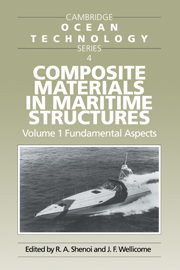Book contents
- Frontmatter
- Contents
- Preface
- List of Authors
- 1 A Strategic Overview
- 2 Background to Materials Science
- 3 Environmental Aspects
- 4 Production by Resin Transfer Moulding
- 5 An Engineering Approach to the Prediction of Elastic Properties of a Laminate
- 6 Mechanics of Orthotropic Laminae
- 7 Analysis of Laminated Composites
- 8 Theory of Sandwich Beams and Plates
- 9 Design of Anisotropic Panels
- 10 Finite Element Analysis of Composites
- 11 Theoretical Predictions of Failure Mechanisms and Strength
- 12 Considerations of Failure Theories in Design
- 13 The Procedures and Standards
- Appendix
- Index
5 - An Engineering Approach to the Prediction of Elastic Properties of a Laminate
Published online by Cambridge University Press: 04 August 2010
- Frontmatter
- Contents
- Preface
- List of Authors
- 1 A Strategic Overview
- 2 Background to Materials Science
- 3 Environmental Aspects
- 4 Production by Resin Transfer Moulding
- 5 An Engineering Approach to the Prediction of Elastic Properties of a Laminate
- 6 Mechanics of Orthotropic Laminae
- 7 Analysis of Laminated Composites
- 8 Theory of Sandwich Beams and Plates
- 9 Design of Anisotropic Panels
- 10 Finite Element Analysis of Composites
- 11 Theoretical Predictions of Failure Mechanisms and Strength
- 12 Considerations of Failure Theories in Design
- 13 The Procedures and Standards
- Appendix
- Index
Summary
INTRODUCTION
Early approaches to calculate mechanical properties of fibre reinforced composites were based on simple models of fibre-matrix interaction or on rule-of-mixtures formulae in which fibres and matrix were assumed to act together in series or parallel. Application of energy theorems to composite behaviour showed that the assumptions of parallel or series connection between fibres and matrix yield upper and lower bounds on effective moduli. Subsequent work dealt primarily with the requirement of energy methods to achieve closer spacing of the bounds and to provide solutions for a range of possible fibre-matrix geometries. The purpose of this Chapter is to provide the reader with a simple exposition of procedures for calculating elastic properties of composites which are amenable to easy, practical application.
VOLUME AND WEIGHT FRACTIONS
One of the primary factors which determines the properties of composites is the relative proportions of the fibres and matrix. The relative proportions can be in terms of weight or volume fractions. Weight fractions are easier to obtain during fabrication or by an experimental method after fabrication. Volume fractions, on the other hand, are more convenient for theoretical calculations. Hence it is desirable to determine expressions for conversion between weight and volume fractions.
Consider a case with weights/volumes of the fibres, matrix and net composite being wf/vf, wm/vm and wc/vc respectively. (Subscripts f, m and c from here on are consistently used to represent fibres, matrix and composite.) Let the volume and weight fractions be denoted by V and W respectively.
- Type
- Chapter
- Information
- Composite Materials in Maritime Structures , pp. 127 - 141Publisher: Cambridge University PressPrint publication year: 1993



